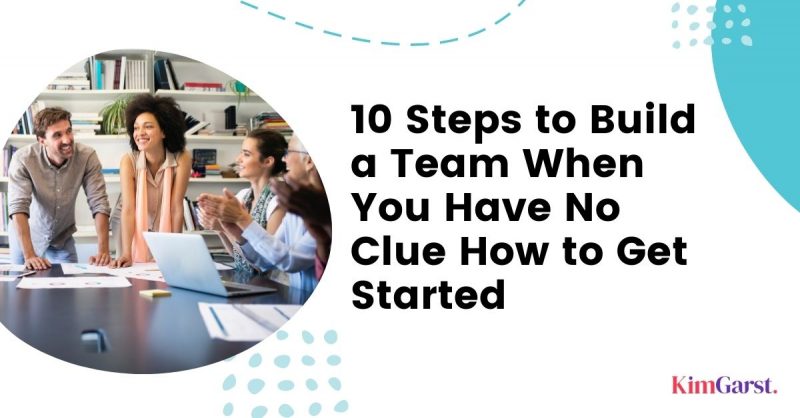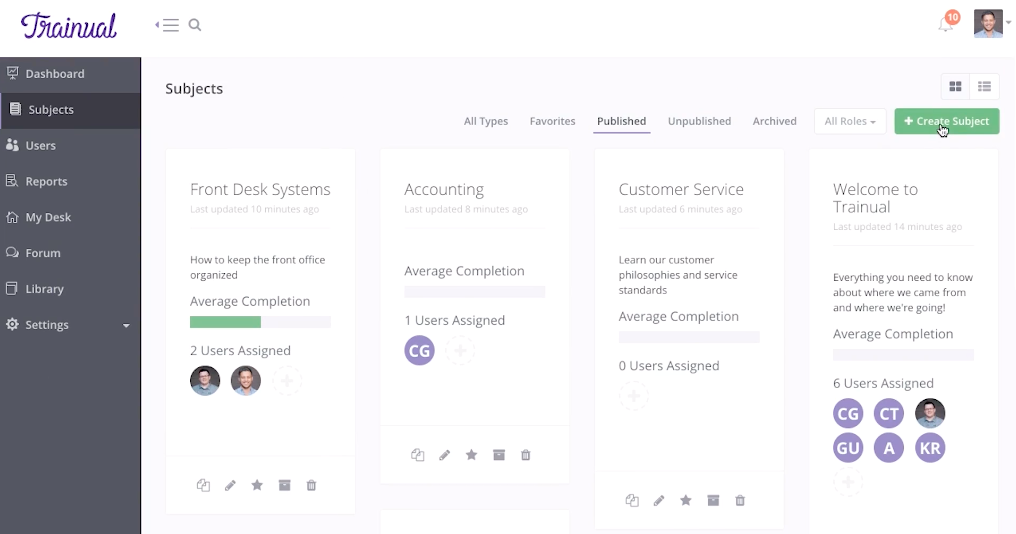Are you at the point in your business where you’ve realized you can’t do it all and thinking to build a team?
Are you tired of trying to be a Jack or Jill-of-all-trades, and just want to focus on the stuff you’re good at and actually enjoy?
Where you want to focus more on building and scaling your business, and less on day-to-day operations?
If so, this may be the perfect time for you to build a team.
BUT…as a service-based business owner who’s used to do everything yourself, the prospect of interviewing candidates and picking team members – along with everything that it entails – can feel overwhelming.
In this post, I’m going to lay out 10 steps you can follow when you’re ready to build a team but have no idea where to start.
You might be asking: How do I know WHEN it’s time to build a team?
Great question…let’s take a quick look!
How to Know When it’s Time to Build a Team
This is a huge decision for many business owners. You’re so used to doing everything on your own, and the idea of taking that next step can feel really scary.
So, how do you know when it’s actually time to take that step?
The #1 sign it’s time to build a team is that you’re consistently overwhelmed, overworked and overcommitted.
The #1 sign it’s time to build a team is that you’re consistently overwhelmed, overworked and overcommitted.Click To TweetYou likely feel like there’s never enough time to get everything done, and that while you might be meeting the current demands of your clients – barely – everything else seems to be falling through the cracks.
While this is a GOOD problem to have, it’s a problem, nevertheless.
Living in this constant state of overwhelm will eventually take its toll on you – both personally and professionally.
It’s also not the ideal way to grow a business or scale a business…so if that’s something you’re shooting for, this is a definite sign it’s time to build a team!
Wondering what other signs or symptoms are telling you it’s time to expand and grow your team? Check out my post, 10 Surefire Signs It's Time to Hire a Team or Outsource.
Now, onto the good stuff. Ready to hire a team? Here are 10 steps you can follow when you have no clue how or where to start!
10 Steps to Build a Team When You Have No Clue How to Start
1. Define Your Company Culture
Start with figuring out WHY you do what you do…then move on to the how and what. Via Simon Sinek
Before you even start thinking about what roles you need to fill, it’s super important to think about the values and culture of your business.
The trouble is, if you’ve been a solopreneur for a while, this may be something you haven’t even thought about.
So, where to start?
Ask yourself the following questions:
- What is my “Why”? Why did I start this business? What am I passionate about? WHO am I passionate about serving? If you can communicate your “why” to potential candidates, you stand a much better chance of finding others who share your passion and values.
- What values are most important to me in life and in business? For instance, are honesty and integrity the most important thing to me? Or is it more important to me to foster a fun, dynamic workplace?
- What words do you use (or do you WANT to use) to describe your company? This little exercise can reveal values or goals you may not have thought of. Some words to choose from can include transparent, collaborative, work-life balance, growth-oriented, fun, relaxed, research-driven, or diverse.
- What are the observable artifacts of your company? These are all the visible things that define your company – like your office furniture and décor, the colors you choose, your logo and branding elements, the clothes people wear to the office, etc. These can all tell you something important about your company culture, so don’t skip this step!
2. Have Your Systems in Place
One of the biggest mistakes you can make when building a team is not having documented systems and processes in place.
Systems ensure everyone on your team knows what they’re responsible for, where they fit within the company, and how they need to carry out their responsibilities.
Systems ensure everyone on your team knows what they’re responsible for, where they fit within the company, and how they need to carry out their responsibilities.Click To TweetIt also ensures greater consistency when it comes to repeatable tasks– which is especially important when bringing on new team members
While it’s important to create systems for each area of your business, I recommend starting with the areas you plan to hire for first. For instance, if you desperately need help with your marketing, start by systemizing your most frequent marketing tasks: like creating social media content and writing blog posts.
This way, when you hire your first marketing manager, you have everything in place for him or her to get to work ASAP!
Not sure where to start with systemizing your business and documenting your processes? Check out my post, How to Systemize Your Business to Grow and Scale in a Manageable but Profitable Way.
3. Create Your Job Descriptions
If you’re trying to fill an existing role, this process is a whole lot easier. But if you’ve never had anyone in a particular role, how on earth do you know what you’re looking for??
Some elements you’ll need to consider include:
- Job title
- Years of related work experience required
- Education required
- Hard skills required – like experience with certain software, accounting skills, programming skills, etc.
- Soft skills required – like good communication skills, willingness to learn, positive attitude, etc.
- Responsibilities of the job
- Physical demands of the job
- General pay range
- Date when the application closes (and also when the new role starts)
It’s also a good idea to talk a little bit about your company, so you attract the right kinds of candidates and set your job listing apart from the others your candidates will see.
For instance, you can talk about your company culture (see #1 above), awards your company has received, health benefits and holiday time offered, and anything else that you think makes your business an amazing place to work!
4. Advertise Your Positions
Here is where it starts to get real.
I always recommend starting with personal recommendations from friends and colleagues. In fact, some research suggests that as many as 85% of all jobs are filled via networking…it’s that effective.
However, if you’re not able to find someone through personal referrals, all is definitely not lost. Here’s a simple process you can use to find the perfect people for your team!
- Post your job description on your business website
- Promote the job opening on all your social media accounts (especially LinkedIn)
- Send the job opening to your email list
- Distribute to niche job sites, as well as general job sites like monster.com
- For highly-specialized jobs, consider advertising in trade magazines or on industry websites.
Knowing which sites to post jobs can be a challenge. Some that you’ll want to look into include Indeed, Glassdoor, CareerBuilder, ZipRecruiter, and of course LinkedIn.
If you’re looking for contractors rather than employees, definitely look into Upwork and Freelancer.com as well.
You’ll also want to post to specialized job boards, as these will be a great source of high-quality candidates. For instance, if you’re looking for a blogger, try ProBlogger; if you’re looking for a graphic designer, try CreativeMornings; or if you’re looking for a VA, try posting to the job board at VirtualAssistants.com.
5. Interview Candidates
Interviewing candidates will give you the best chance of finding out if someone is a good fit…so make the process count.
As much as you’re able, structure the interview environment to reduce candidates’ stress. One of the best ways to do this is to introduce yourself right off the bat, and then let them know what the interview will consist of.
Next, you’ll want to ask some basic questions, including:
- Why do you want this job?
- The reason you leaving your current job?
- Why do you think you’d be a good fit for this company?
- What are your salary expectations?
- What are your career goals?
You’ll also want to consider asking behavioral questions, as these will give you a better sense of how your candidates will act in certain situations. The framework I like best for behavioral interviews is the STAR method.
Basically, how it works is that you ask your candidate to talk about a problem or dilemma they faced in the past, and to explain how they overcame it. For instance, you could ask them to describe a time when they had to complete a task but had no idea where to start; or how they handled a situation in which they had a conflict with a co-worker.
Their answers should be structured as follows:
Situation: Describe the situation, including what happened and who was involved.
Task: What was the ultimate goal of this situation? What task were you trying to complete? What was the desired outcome?
Action: What actions or steps did you take to overcome the problem?
Results: What ultimately happened? Did you reach your goal? What did you learn through this situation?
As you can imagine, this will give you a much better sense of a candidate’s personality and skill set than if you simply asked the typical, “What are your greatest strengths and weaknesses” question!
6. Choose The Best Candidates for The Job
Once your interviews are done, it’s time to narrow down your choices and find the best person for the job.
But this is sometimes easier said than done!
I’m a big fan of going with my gut – but of course, your instincts also have to be weighed against the facts.
References: You should always, always contact references… don't just take their word for it! Ask how easy the person was to work with, how reliable they were, and whether there is anything else you should know about the candidate (open-ended questions are great for giving the person a chance to share stuff you may not have asked about).
Background research: A simple Google search can reveal a lot about a person! You should also look through their social media profiles to make sure nothing questionable or unsavory comes up.
Cultural fit: Sometimes the best candidates on paper just didn’t jibe with your company culture. For instance, you might find someone has received all sorts of awards and a 4.0 GPA in college but has zero interest in occasionally going out for dinner after work as a team. This may be a red flag that this person just won’t be a good long-term fit for your team!
Soft skills: Hard skills are obviously important. But, I’d rather hire someone who is teachable and who has good communication skills than someone who can complete tasks well but who is impossible to work with!
Another decision you’ll have to make when picking team members is who to hire first. You might need to fill a number of different roles, so what’s the best way to approach this?
I’d recommend starting off with any managerial positions you need to be filled. These will be the “big picture” people who will play key roles within your company. Some examples might be project manager, product manager, chief marketing officer or financial officer.
And remember: Once you’ve found the right people for these roles, they will be a huge help to you as you hire, interview and train the rest of your team members.
7. Train Your New Hires
Use a tool like Trainual to make onboarding and training SO much easier!
I already talked about the importance of having systems in place.
And one of these systems should most definitely be your process of onboarding and training new hires.
What does this look like exactly?
Start by making sure all the basics are in place, so your new employee can jump into their role right away. This might include making sure phones and email accounts are set up, logins and passwords are created, and that he or she has access to all the tools and resources they need to get started.
It also means making sure your new team member feels comfortable and welcome. Introduce him or her to their fellow team members, and consider pairing them with a work “buddy” who will be there to answer their questions and show them the ropes during the first couple of weeks.
Finally, make sure you have an official training process in place for new hires. This could include a hard-copy training manual, or an online policy guide created using a tool like Trainual. It will also include some degree of one-on-one training and support, as well as clearly communicating your expectations about the role, and answering any questions your new employee may have about the company or their role.
8. Keep Communications Open
Now that you’ve hired and trained your new team members, your work isn’t over…not by a long shot.
It’s time to nurture your relationships with your team members and really grow your team in a sustainable way.
One way you’ll want to do this is by regularly holding meetings with your entire team. They don’t have to be long, involved, or even in-person – the point is simply to keep the lines of communication open.
You’ll also want to schedule periodic one-on-one meetings where you can connect in a more personal way with each individual team member. This will give them a chance to ask questions or share any concerns…BEFORE those issues become major problems. And this is key when building a strong team!
Finally, I highly recommend making use of collaboration tools, especially if you’re building a remote team. For instance, my team uses Slack to keep in touch about day-to-day tasks and to upload documents, as well as Monday to manage workflows and keep all our important data in one place.
9. Set Ground Rules for Your Team
At this point, you’ve hired an amazing team of highly-qualified, personable people who embrace your company’s mission and values.
They’ve also been trained and understand exactly which tasks they’ll be responsible for…as well as knowing exactly how they should complete those tasks.
However, you’ll want to take this a step further and actually brainstorm some ground rules to ensure everyone is on the same page in terms of expectations and acceptable behaviors. These ground rules shouldn’t just be a list of rules you pass on to your team members – it should be a collaborative document that everyone on the team has input into. These rules will dictate how team members treat each other, how trust is built, and how decisions will be made.
Some example ground rules could include:
- Not be afraid to ask for help if we get stuck completing a task
- Ask questions if need be, and no question is too small
- Always be honest with our team members, no matter the cost
- When conflict arises, we will always talk directly with the person we have the disagreement with (rather than talking to others about it)
- If the majority of our team agrees on a particular decision, we will support them even if we don’t agree personally
Of course, there are MANY more rules you could potentially have within your team. But hopefully, this gives you a good idea of how to get started!
10. Incorporate Regular Team-Building Activities
Meetings are important, but they may not do much in terms of fostering connecting and relationship between your team members. This is where team-building activities come in.
Keep in mind these activities aren’t just “fun and games”! Research tells us that team-building exercises actually improve goal setting, interpersonal relationships, problem-solving, and role-clarification.
If your team members all live locally, these types of activities and events are much easier to put together. However, with a remote team, you have to be particularly intentional about fostering connections.
Here are some ideas to help you get the ball rolling.
Zoom coffee chats. These aren’t formal meetings, and there aren’t any agendas. These are simply scheduled opportunities for everyone to show up via Zoom and engage in some casual, “lunchroom banter”.
Virtual work buddies. Once each month, randomly pair up team members to meet virtually, have a chat, or simply put in an hour’s worth of work…together. This is a great way for your team members to get to know one another – especially those whose paths may not naturally cross from day to day.
Birthday videos. This is something we do here at Kim Garst. Much of our team works remotely, but we still want to make sure everyone feels special and celebrated on their birthday. So, when someone’s birthday is coming up, each member of our team creates a birthday greeting letting them know how special and appreciated they are. We then compile all the greetings into a video they get to open up on their special day!
‘A day in the life’ photos. This is an easy way to go a little bit deeper than simply sharing about work-related stuff. Have everyone take a picture of something in their lives and share it in your company Slack channel or via another communication tool. It could be a picture of their kids, their workspace, a recent holiday…whatever they want. This is a simple, but a non-threatening way to get people sharing something a little more personal with their teammates.
Final Thoughts
We’ve covered a lot of ground in this post!
I know when I was building my first team, I had no idea where to start…and I’m guessing many of you feel this way too.
This post was designed to give you a step-by-step process you can follow to help you find, hire and train your team – from scratch.
While the process of building a team is certainly time-consuming, I guarantee you’ll find all the hard work is worth it…saving you time, money, and a TON of frustration in the long run!
Are you ready to build a team? If not, what’s holding you back? If you answered “yes”, what’s the first step you’re going to take? Share in the comments below!
About Author
Kim Garst
Kim Garst is a renowned marketing strategist and speaker who is trailblazing the use of artificial intelligence in digital marketing. With over 30 years of experience as an online entrepreneur, Kim helps entrepreneurs grow their business and authority online by using AI technology. She is leading the way with proven AI frameworks that help entrepreneurs build authority in their space.
She is keynote speaker and an international best-selling author of Will The Real You Please Stand Up, Show Up, Be Authentic and Prosper in Social Media.
Named by Forbes as a Top 10 Social Media Power Influencer, Kim is well-known for her skill to simplify complex technology and make the use of AI understandable for business growth. Her relatable, actionable advice helps guide new entrepreneurs to harness the power of AI to succeed in digital marketing. Kim is leading the way in combining human and technological skills to create a new model for AI-powered marketing.













helpful information. Thank you and keep doing the amazing work.
Hi Kim, Nice Post, Thanks for sharing that information
Thank you for sharing beautiful thoughts.